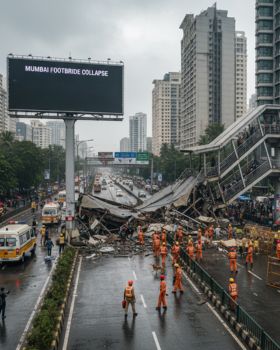
Disclaimer:
This article is intended for informational purposes only and is based on publicly available sources regarding the Versailles Wedding Hall Disaster. It does not aim to assign blame or liability to any individual or organization involved in the incident. The discussion of modern contractor management software is speculative and illustrative, highlighting how contemporary tools might support safer practices. Any references to SHEQ Network solutions are promotional in nature and not a direct critique or analysis of historical events. Always consult qualified engineering, legal, or safety professionals for specific advice related to construction safety and compliance.
The Versailles Wedding Hall Disaster remains one of the most tragic building collapses in Israel’s history. On May 24, 2001, during a joyous wedding celebration in Jerusalem, the third-floor dance hall of the Versailles wedding hall suddenly collapsed. In a matter of seconds, dozens of guests were plunged through the floor to the levels below. This catastrophic event claimed 23 lives and injured over 380 people, leaving a lasting impact on the nation and the global construction community.
Understanding the Collapse: What Went Wrong?
The Versailles Wedding Hall collapse was not simply an accident—it was the result of multiple overlooked risks. Investigations later identified the primary cause: the Pal-Kal construction method, a building system that was widely known for its structural weaknesses. Unfortunately, despite earlier warnings about the limitations of this method, it continued to be used.
Additionally, modifications were made to the structure without proper engineering reviews or approvals. These changes further weakened the building and directly contributed to the collapse.
The disaster was a harsh reminder of what can happen when there is insufficient contractor oversight, missing documentation, and poor communication between construction teams and project managers.
Could Contractor Software Have Helped?
Although contractor software in its modern digital form did not exist at the time of the Versailles Wedding Hall disaster, the lessons learned from such tragedies have contributed to the development of today’s contractor management solutions.
It is reasonable to suggest that if more robust contractor management platform and stricter safety oversight tools had been available or widely used, they could have helped improve record-keeping, verification processes, and safety compliance. Such systems today support better organization and offer real-time access to contractor qualifications, work permits, and change request approvals, which may contribute to safer project outcomes.
However, it is important to remember that no system can guarantee the prevention of every incident. The key value is in supporting safer practices and facilitating better decision-making.
Key Safety Takeaways from the Versailles Wedding Hall Disaster
1. Importance of Verified Construction Methods
The collapse emphasized the need to carefully review and approve construction methods. In the case of the Versailles Wedding Hall, a method that was already flagged as unsafe was still used, leading to devastating consequences.
2. Proper Documentation is Essential
A significant gap in the Versailles Wedding Hall project was the lack of structured documentation and control over site changes. Critical decisions were not properly recorded or reviewed, which made it easier for mistakes to go unnoticed.
3. Continuous Contractor Oversight
Oversight does not always mean real-time monitoring of every task, but consistent reviews, scheduled inspections, and a clear trail of contractor qualifications can strengthen project safety. Today, contractor management platforms can help in maintaining this structured approach.
4. Approval and Change Control
Unapproved modifications contributed to the Versailles Wedding Hall collapse. Establishing clear workflows for requesting and approving changes is essential. Modern tools could have helped by providing structured approval chains and alerts for any unauthorized changes.
5. Learning from Past Incidents
One of the most valuable aspects of revisiting this disaster is understanding how future projects can adopt better safety practices. The construction industry has since advanced in terms of technology, compliance, and training—but continuous vigilance is required.
How Modern Contractor Software Could Help Improve Safety
While contractor software cannot eliminate all risks, it can play a supportive role in promoting safer construction practices. These platforms could help by:
- Providing centralized access to contractor qualifications and certifications.
- Ensuring consistent tracking of work permits, safety documentation, and approval workflows.
- Supporting a clear change management process to avoid unauthorized modifications.
- Helping maintain a traceable record of contractor activities and site requirements.
A modern contractor management platform is designed to help businesses stay organized, improve oversight, and enhance communication between project stakeholders. By digitizing records and creating transparent workflows, such platforms could help prevent critical errors from being overlooked.
Conclusion: Supporting Safer Worksites with Contractor Management Software
Tragic events like the Versailles Wedding Hall Disaster offer vital lessons about the importance of structured contractor oversight, proper documentation, and responsible construction practices. While no software can prevent every incident, having a contractor management platform in place today could help organizations strengthen their safety procedures, streamline permit management, and ensure contractor qualifications are up-to-date.
By using reliable contractor software, businesses can improve the way they track compliance, manage documentation, and handle approvals—all of which contribute to better project outcomes and potentially safer worksites. These solutions provide an additional layer of support for businesses aiming to maintain high safety standards.
When safety is prioritized, and the right tools are in place, we can move closer to reducing the likelihood of preventable tragedies.
🔗 Learn more at sheqnetwork.com and transform the way you manage contractor safety today.
👉 Ready to see it in action? Book your free demo here!
Ready to transform? Contact us today at info@sheqnetwork.com or call us at +353 21 4536034 for a personalized demo!



